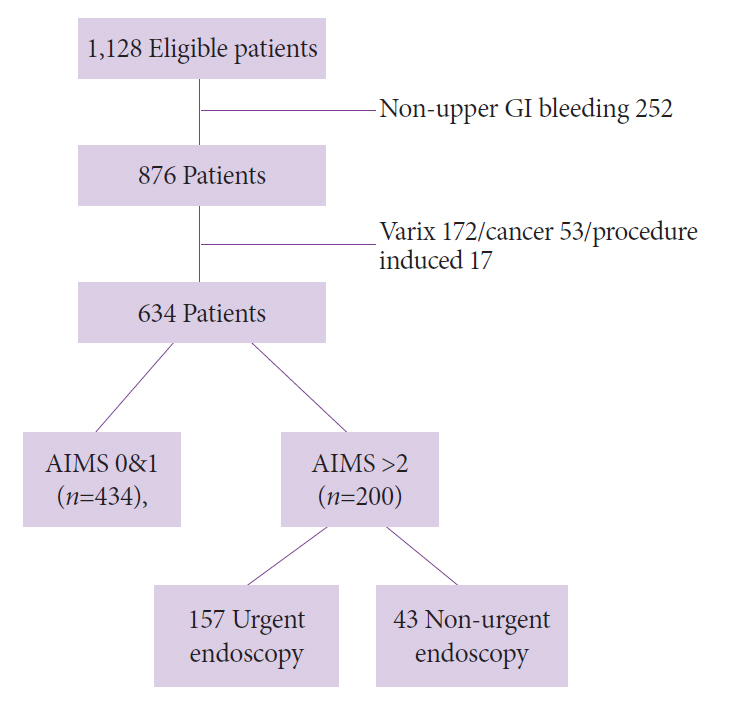Clin Endosc.
2015 Nov;48(6):522-527. 10.5946/ce.2015.48.6.522.
The AIMS65 Score Is a Useful Predictor of Mortality in Patients with Nonvariceal Upper Gastrointestinal Bleeding: Urgent Endoscopy in Patients with High AIMS65 Scores
- Affiliations
-
- 1Division of Gastroenterology and Hepatology, Department of Internal Medicine, Chungnam National University Hospital, Chungnam National University School of Medicine, Daejeon, Korea. mhs1357@cnuh.co.kr
- KMID: 2380410
- DOI: http://doi.org/10.5946/ce.2015.48.6.522
Abstract
- BACKGROUND/AIMS
To validate the AIMS65 score for predicting mortality of patients with nonvariceal upper gastrointestinal bleeding and to evaluate the effectiveness of urgent (<8 hours) endoscopic procedures in patients with high AIMS65 scores.
METHODS
This was a 5-year single-center, retrospective study. Nonvariceal, upper gastrointestinal bleeding was assessed by using the AIM65 and Rockall scores. Scores for mortality were assessed by calculating the area under the receiver-operating characteristic curve (AUROC). Patients with high AIMS65 scores (> or =2) were allocated to either the urgent or non-urgent endoscopic procedure group. In-hospital mortality, success of endoscopic procedure, recurrence of bleeding, admission period, and dose of transfusion were compared between groups.
RESULTS
A total of 634 patients were analyzed. The AIMS65 score successfully predicted mortality (AUROC=0.943; 95% confidence interval [CI], 0.876 to 0.99) and was superior to the Rockall score (AUROC=0.856; 95% CI, 0.743 to 0.969) in predicting mortality. The group with high AIMS65 score included 200 patients. The urgent endoscopic procedure group had reduced hospitalization periods (p<0.05)
CONCLUSIONS
AIMS65 score may be useful in predicting mortality in patients with nonvariceal upper gastrointestinal bleeding. Urgent endoscopic procedures in patients with high scores may be related to reduced hospitalization periods.
MeSH Terms
Figure
Cited by 1 articles
-
Can AIMS65 Save the Endoscopists from Midnight Calls?
Joon Sung Kim, Byung-Wook Kim
Clin Endosc. 2015;48(6):459-460. doi: 10.5946/ce.2015.48.6.459.
Reference
-
1. Lau JY, Barkun A, Fan DM, Kuipers EJ, Yang YS, Chan FK. Challenges in the management of acute peptic ulcer bleeding. Lancet. 2013; 381:2033–2043.
Article2. Hearnshaw SA, Logan RF, Lowe D, Travis SP, Murphy MF, Palmer KR. Use of endoscopy for management of acute upper gastrointestinal bleeding in the UK: results of a nationwide audit. Gut. 2010; 59:1022–1029.
Article3. Lee JG, Turnipseed S, Romano PS, et al. Endoscopy-based triage significantly reduces hospitalization rates and costs of treating upper GI bleeding: a randomized controlled trial. Gastrointest Endosc. 1999; 50:755–761.
Article4. Bjorkman DJ, Zaman A, Fennerty MB, Lieberman D, Disario JA, Guest-Warnick G. Urgent vs. elective endoscopy for acute non-variceal upper-GI bleeding: an effectiveness study. Gastrointest Endosc. 2004; 60:1–8.
Article5. Spiegel BM, Vakil NB, Ofman JJ. Endoscopy for acute nonvariceal upper gastrointestinal tract hemorrhage: is sooner better? A systematic review. Arch Intern Med. 2001; 161:1393–1404.6. Tai CM, Huang SP, Wang HP, et al. High-risk ED patients with nonvariceal upper gastrointestinal hemorrhage undergoing emergency or urgent endoscopy: a retrospective analysis. Am J Emerg Med. 2007; 25:273–278.
Article7. Cooper GS, Chak A, Way LE, Hammar PJ, Harper DL, Rosenthal GE. Early endoscopy in upper gastrointestinal hemorrhage: associations with recurrent bleeding, surgery, and length of hospital stay. Gastrointest Endosc. 1999; 49:145–152.
Article8. Leontiadis GI, Sharma VK, Howden CW. Systematic review and meta-analysis of proton pump inhibitor therapy in peptic ulcer bleeding. BMJ. 2005; 330:568.
Article9. Leontiadis GI, Sharma VK, Howden CW. Systematic review and meta-analysis: enhanced efficacy of proton-pump inhibitor therapy for peptic ulcer bleeding in Asia: a post hoc analysis from the Cochrane Collaboration. Aliment Pharmacol Ther. 2005; 21:1055–1061.10. Rockall TA, Logan RF, Devlin HB, Northfield TC. Risk assessment after acute upper gastrointestinal haemorrhage. Gut. 1996; 38:316–321.
Article11. Blatchford O, Murray WR, Blatchford M. A risk score to predict need for treatment for upper-gastrointestinal haemorrhage. Lancet. 2000; 356:1318–1321.
Article12. Stanley AJ, Ashley D, Dalton HR, et al. Outpatient management of patients with low-risk upper-gastrointestinal haemorrhage: multicentre validation and prospective evaluation. Lancet. 2009; 373:42–47.
Article13. Saltzman JR, Tabak YP, Hyett BH, Sun X, Travis AC, Johannes RS. A simple risk score accurately predicts in-hospital mortality, length of stay, and cost in acute upper GI bleeding. Gastrointest Endosc. 2011; 74:1215–1224.
Article14. Hyett BH, Abougergi MS, Charpentier JP, et al. The AIMS65 score compared with the Glasgow-Blatchford score in predicting outcomes in upper GI bleeding. Gastrointest Endosc. 2013; 77:551–557.
Article15. Nakamura S, Matsumoto T, Sugimori H, Esaki M, Kitazono T, Hashizume M. Emergency endoscopy for acute gastrointestinal bleeding: prognostic value of endoscopic hemostasis and the AIMS65 score in Japanese patients. Dig Endosc. 2014; 26:369–376.16. Gaduputi V, Abdulsamad M, Tariq H, et al. Prognostic value of AIMS65 score in cirrhotic patients with upper gastrointestinal bleeding. Gastroenterol Res Pract. 2014; 2014:787256.
Article17. Jung SH, Oh JH, Lee HY, et al. Is the AIMS65 score useful in predicting outcomes in peptic ulcer bleeding? World J Gastroenterol. 2014; 20:1846–1851.18. Beyth RJ, Quinn LM, Landefeld CS. Prospective evaluation of an index for predicting the risk of major bleeding in outpatients treated with warfarin. Am J Med. 1998; 105:91–99.19. Fang MC, Go AS, Chang Y, et al. A new risk scheme to predict warfarin-associated hemorrhage: The ATRIA (Anticoagulation and Risk Factors in Atrial Fibrillation) Study. J Am Coll Cardiol. 2011; 58:395–401.20. Kirk AP, Dooley JS, Hunt RH. Peptic ulceration in patients with chronic liver disease. Dig Dis Sci. 1980; 25:756–760.
Article21. Siringo S, Burroughs AK, Bolondi L, et al. Peptic ulcer and its course in cirrhosis: an endoscopic and clinical prospective study. J Hepatol. 1995; 22:633–641.
Article
- Full Text Links
- Actions
-
Cited
- CITED
-
- Close
- Share
- Similar articles
-
- Prospective Comparison of the AIMS65 Score, Glasgow-Blatchford Score, and Rockall Score for Predicting Clinical Outcomes in Patients with Variceal and Nonvariceal Upper Gastrointestinal Bleeding
- Comparison of AIMS65 Score and Other Scoring Systems for Predicting Clinical Outcomes in Koreans with Nonvariceal Upper Gastrointestinal Bleeding
- Clinical Application of AIMS65 Scores to Predict Outcomes in Patients with Upper Gastrointestinal Hemorrhage
- Is the AIMS 65 Score Useful in Prepdicting Clinical Outcomes in Korean Patients with Variceal and Nonvariceal Upper Gastrointestinal Bleeding?
- Comparison of the AIMS65 Score with Other Risk Stratification Scores in Upper Variceal and Nonvariceal Gastrointestinal Bleeding



